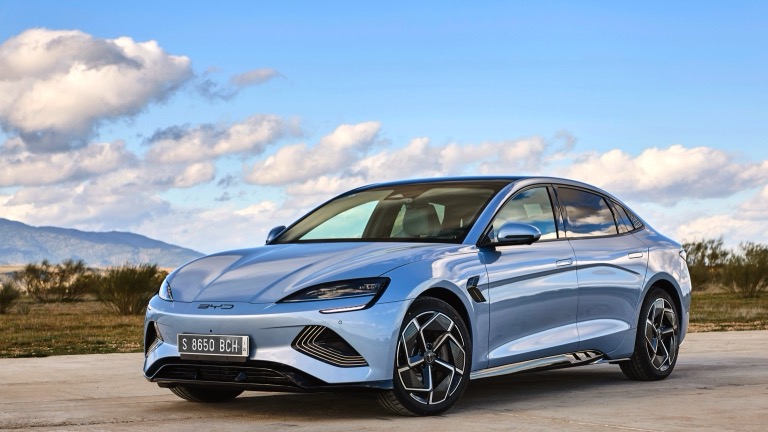
BYD’s presence in Australia has moved from niche to mainstream with remarkable speed. Once a minor player in the local market, the Chinese manufacturer has used competitive pricing, a broad model line-up and tighter control of its supply chain to establish itself as one of Australia’s most contested EV brands. By mid‑2025 BYD’s momentum was clear: industry reports point to more than 40,000 sales in the first half of 2025 and cumulative Australian registrations exceeding 60,000 by July 2025. In August 2025 BYD briefly led EV monthly registrations ahead of Tesla – a symbolic milestone that underscores how quickly the market dynamics are shifting.
Why BYD’s growth matters
- Affordability at scale: BYD has deliberately targeted the price-sensitive segment of the Australian market. Models such as the Dolphin (priced under $30,000 in some specifications) and the competitively positioned Sealion 7 give consumers lower‑entry options that shorten the payback horizon compared with many established EVs.
- Product breadth: BYD’s local line-up – including the compact Atto 3, the Dolphin city car, the Seal saloon and larger SUV offerings such as the Sealion 7 – enables the company to compete across multiple segments rather than relying on a single halo model.
- Vertical integration: BYD manufactures batteries and many key components in‑house, which helps reduce unit costs and manage supply. The brand’s adoption of energy-dense, safe battery chemistries (notably its so‑called “Blade” battery technology) has been a consistent talking point for its value proposition.
- Direct distribution: BYD moved away from its previous partnership with EV Direct and now manages imports and distribution directly. That shift gives BYD more control over pricing, allocation of stock, warranty fulfilment and after‑sales networks.
What the numbers tell us
The headline figures – tens of thousands of sales within a short market tenure and a one‑month lead over Tesla – are impressive. They reflect a confluence of factors: aggressive pricing strategies, expanding dealer and service footprints, and a growing appetite among Australian consumers for battery electric vehicles. As with all early market surges, the figures also invite scrutiny: one‑month registration leads can be driven by stock timing and dealer incentives as much as structural demand, and sales targets can be revised as supply realities evolve.
Distribution and after‑sales: why direct control matters
BYD’s decision to repatriate distribution from a third party to its own channels is more than an operational reshuffle. Direct distribution typically allows a manufacturer to:
- Set national pricing and promotions consistently.
- Control stock allocation to priority markets and retail partners.
- Standardise dealer training, warranty processing and repair procedures.
- Capture higher retail margins and invest more in local service infrastructure.
For Australian buyers this should translate into clearer pricing, potentially faster access to vehicles, and more consistent after‑sales experiences – provided BYD continues to invest in local service centres and parts logistics.
Competitive landscape and dealer dynamics
BYD’s pricing strategy places it squarely against legacy and newer EV entrants. Brands such as Tesla, Hyundai, Kia, MG and Volkswagen are all recalibrating pricing, model mix and local offers to protect market share. For dealers and independent service networks, BYD’s expansion presents opportunities (increased traffic, replacement parts and service revenue) but also cross‑pressures as margins and customer expectations change.
Consumer impact: choice, cost and charging
For many Australian buyers, cost remains the single biggest barrier to EV adoption. BYD’s lower price points increase the number of households who can realistically consider a battery electric vehicle without substantial government subsidies. However, buyers should still weigh:
- Total cost of ownership: purchase price is only one input; running costs, insurance, financing, and expected resale values matter.
- Charging access: while public fast‑charging networks are expanding, regional and suburban disparities persist. Home charging remains the simplest option for many BYD owners.
- After‑sales support: warranty terms, availability of parts and trained technicians are critical. BYD’s direct distribution aims to improve these outcomes but execution will be key.
Regulatory and policy context
Australia’s transition to electric mobility is driven by a mix of market forces and incremental policy levers. State and federal incentives and regulations differ, and infrastructure funding is gradually increasing. BYD’s growth adds urgency to policy conversations about public charging networks, grid impacts and incentives to ensure that access and support scale with vehicle uptake.
Risks and challenges
- Market volatility: aggressive pricing can lead to temporary spikes in registrations but may be hard to sustain if input costs rise or if competitors undercut prices.
- Service capacity: rapid sales growth demands commensurate investment in service networks and parts supply; any shortfall risks reputational damage.
- Resale values and residual risk: as more EVs enter the used market, residual values will evolve. Buyers should assess residual value forecasts and warranty coverage.
- Competition and innovation: legacy automakers and other Chinese brands are accelerating their EV strategies; long‑term leadership is not guaranteed.
Outlook: where BYD might go next
Expect BYD to continue broadening its Australia portfolio and to consolidate control over distribution and after‑sales. The company’s emphasis on affordable, well‑spec’d models makes it a credible contender for mainstream market leadership. That said, sustained success will depend on execution: maintaining competitive margins, scaling dealer and service networks, and ensuring customer satisfaction as volumes climb.
Conclusion
BYD’s rapid ascent in Australia is one of the clearest signs yet that the country’s vehicle market is transitioning. By combining aggressive pricing, a varied product range and direct control of imports and distribution, BYD has unlocked demand among price‑sensitive buyers and forced incumbents to respond. The short‑term implications are positive for consumer choice and market acceleration; the medium‑term test will be whether BYD can convert early sales momentum into durable market share through robust after‑sales support, stable pricing and continued product development. For Australian motorists, the immediate winners are greater choice and downward pressure on EV pricing. For policymakers and industry participants, the challenge is to ensure charging infrastructure, regulatory frameworks and service capacity keep pace with the rapid change.
FAQs
Is BYD now the best‑selling EV brand in Australia?
BYD briefly led monthly EV registrations ahead of Tesla in August 2025, and its year‑to‑date figures through mid‑2025 show substantial growth. However, leadership in a single month does not necessarily indicate permanent market dominance. Market share should be assessed over longer periods and across segments.
What models does BYD sell in Australia and how much do they cost?
BYD’s local line‑up includes models such as the Dolphin (an affordable compact), Atto 3 (small SUV), the Seal (saloon) and larger SUV models including the Sealion 7. Prices have been aggressively positioned – the Dolphin has been promoted at sub‑$30,000 levels for some variants – but exact pricing varies by specification, dealer offers and any regional incentives.
Why did BYD end its partnership with EV Direct?
BYD moved to direct distribution to exert greater control over pricing, inventory, warranty handling and after‑sales support. Direct management of imports and distribution is a strategic step commonly taken by manufacturers once volumes and market maturity justify the investment.
How will direct distribution affect buyers?
In the short term buyers may see more consistent national pricing and potentially faster access to stock. Over time it should lead to more standardised servicing and warranty processes. The outcome depends on BYD’s investment in local service centres and parts logistics.
How does BYD compare to Tesla on range, tech and charging?
BYD competes primarily on price and value for money. Tesla retains strengths in software, Supercharger network access and certain performance metrics. BYD’s battery technology and vertical integration give it cost and safety advantages in some areas, but comparisons are model‑specific and depend on buyer priorities such as range, features and charging convenience.
Are there any risks buying a BYD in Australia?
Key considerations include the availability of authorised service centres, parts supply, warranty terms, expected resale values and local support. Rapid growth increases the importance of assessing dealer networks and after‑sales capacity before purchase.
About EV Evolution
EV Evolution is the leading online platform dedicated to Australian electric vehicle owners and enthusiasts. We foster a vibrant community, delivering essential EV news and insights, and enhancing user engagement through our innovative, AI-powered chatbot for dynamic discussions. Our mission is to empower Australian electric vehicle owners and enthusiasts by fostering a vibrant, AI-driven online community that connects, informs, and advances the nation’s electric vehicle landscape.




